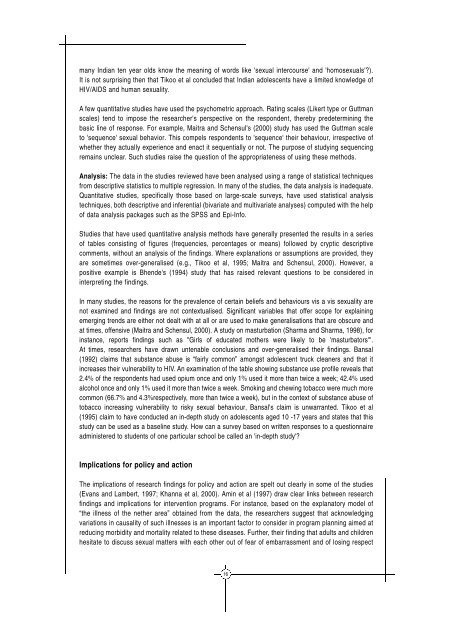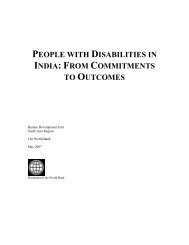FREE Download - TARSHI
FREE Download - TARSHI
FREE Download - TARSHI
Create successful ePaper yourself
Turn your PDF publications into a flip-book with our unique Google optimized e-Paper software.
many Indian ten year olds know the meaning of words like 'sexual intercourse' and 'homosexuals'?).<br />
It is not surprising then that Tikoo et al concluded that Indian adolescents have a limited knowledge of<br />
HIV/AIDS and human sexuality.<br />
A few quantitative studies have used the psychometric approach. Rating scales (Likert type or Guttman<br />
scales) tend to impose the researcher's perspective on the respondent, thereby predetermining the<br />
basic line of response. For example, Maitra and Schensul's (2000) study has used the Guttman scale<br />
to 'sequence' sexual behavior. This compels respondents to 'sequence' their behaviour, irrespective of<br />
whether they actually experience and enact it sequentially or not. The purpose of studying sequencing<br />
remains unclear. Such studies raise the question of the appropriateness of using these methods.<br />
Analysis: The data in the studies reviewed have been analysed using a range of statistical techniques<br />
from descriptive statistics to multiple regression. In many of the studies, the data analysis is inadequate.<br />
Quantitative studies, specifically those based on large-scale surveys, have used statistical analysis<br />
techniques, both descriptive and inferential (bivariate and multivariate analyses) computed with the help<br />
of data analysis packages such as the SPSS and Epi-Info.<br />
Studies that have used quantitative analysis methods have generally presented the results in a series<br />
of tables consisting of figures (frequencies, percentages or means) followed by cryptic descriptive<br />
comments, without an analysis of the findings. Where explanations or assumptions are provided, they<br />
are sometimes over-generalised (e.g., Tikoo et al, 1995; Maitra and Schensul, 2000). However, a<br />
positive example is Bhende's (1994) study that has raised relevant questions to be considered in<br />
interpreting the findings.<br />
In many studies, the reasons for the prevalence of certain beliefs and behaviours vis a vis sexuality are<br />
not examined and findings are not contextualised. Significant variables that offer scope for explaining<br />
emerging trends are either not dealt with at all or are used to make generalisations that are obscure and<br />
at times, offensive (Maitra and Schensul, 2000). A study on masturbation (Sharma and Sharma, 1998), for<br />
instance, reports findings such as "Girls of educated mothers were likely to be 'masturbators'".<br />
At times, researchers have drawn untenable conclusions and over-generalised their findings. Bansal<br />
(1992) claims that substance abuse is “fairly common” amongst adolescent truck cleaners and that it<br />
increases their vulnerability to HIV. An examination of the table showing substance use profile reveals that<br />
2.4% of the respondents had used opium once and only 1% used it more than twice a week; 42.4% used<br />
alcohol once and only 1% used it more than twice a week. Smoking and chewing tobacco were much more<br />
common (66.7% and 4.3%respectively, more than twice a week), but in the context of substance abuse of<br />
tobacco increasing vulnerability to risky sexual behaviour, Bansal's claim is unwarranted. Tikoo et al<br />
(1995) claim to have conducted an in-depth study on adolescents aged 10 -17 years and states that this<br />
study can be used as a baseline study. How can a survey based on written responses to a questionnaire<br />
administered to students of one particular school be called an 'in-depth study'?<br />
Implications for policy and action<br />
The implications of research findings for policy and action are spelt out clearly in some of the studies<br />
(Evans and Lambert, 1997; Khanna et al, 2000). Amin et al (1997) draw clear links between research<br />
findings and implications for intervention programs. For instance, based on the explanatory model of<br />
“the illness of the nether area” obtained from the data, the researchers suggest that acknowledging<br />
variations in causality of such illnesses is an important factor to consider in program planning aimed at<br />
reducing morbidity and mortality related to these diseases. Further, their finding that adults and children<br />
hesitate to discuss sexual matters with each other out of fear of embarrassment and of losing respect<br />
16










